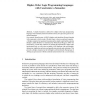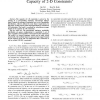7092 search results - page 87 / 1419 » Parallelizing constraint programs |
EUROPAR
2003
Springer
14 years 2 months ago
2003
Springer
Parallel programming is seen as an effective technique to improve the performance of computationally-intensive programs. This is done at the cost of increasing the complexity of t...
CPAIOR
2004
Springer
14 years 2 months ago
2004
Springer
Abstract. Constraint programming based column generation is a hybrid optimization framework recently proposed that uses constraint programming (CP) to solve column generation subpr...
TLCA
2007
Springer
14 years 3 months ago
2007
Springer
A Kripke Semantics is defined for a higher-order logic programming language with constraints, based on Church’s Theory of Types and a generic constraint formalism. Our syntactic...
CORR
2008
Springer
13 years 7 months ago
2008
Springer
The capacity of 1-D constraints is given by the entropy of a corresponding stationary maxentropic Markov chain. Namely, the entropy is maximized over a set of probability distribut...
TIT
2011
13 years 4 months ago
2011
—The capacity of 1-D constraints is given by the entropy of a corresponding stationary maxentropic Markov chain. Namely, the entropy is maximized over a set of probability distri...


